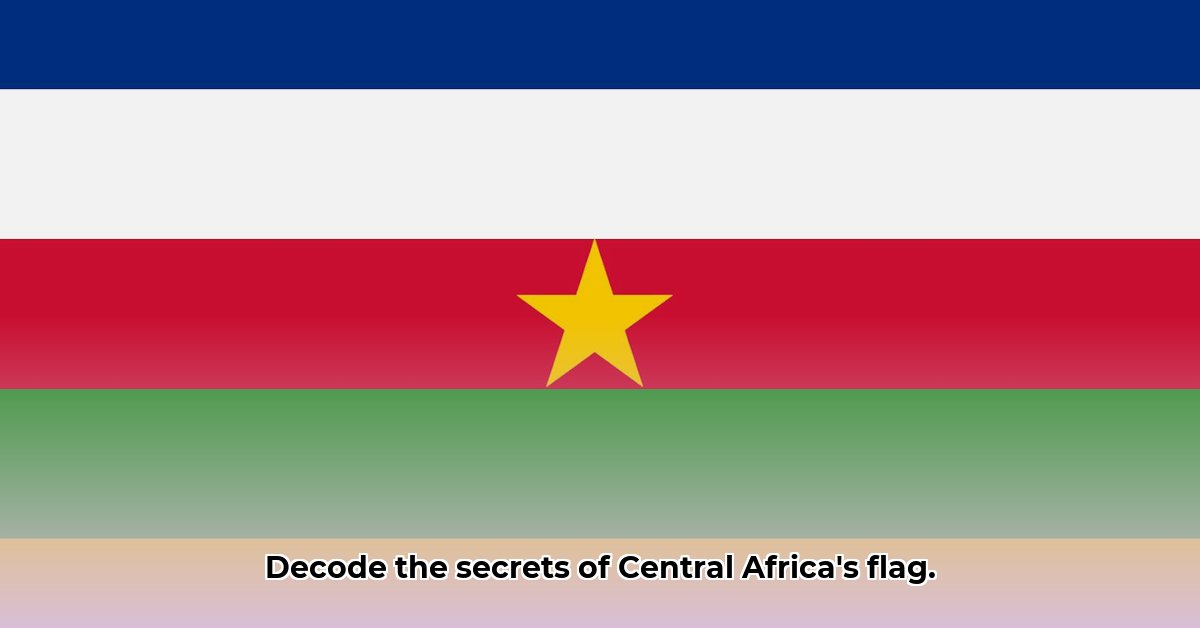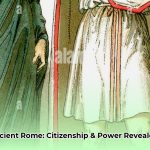Ever noticed the Central African Republic’s flag? It’s a design combining red, green, and blue stripes with a yellow star, but its story is more than meets the eye. This flag is a testament to the country’s history, struggles, and aspirations, offering a deep exploration of its national emblem. For comparison, see how other flags utilize symbolic colors, like the New Mexico flag.
Central Africa Flag: A Story Woven in Cloth and History
The Central African Republic’s flag is a tapestry woven from threads of history, political shifts, and national identity. Adopted in 1958, it features four horizontal stripes of blue, white, green, and yellow with a vertical red band bisecting them. A yellow five-pointed star gleams in the upper left corner. This design masterfully blends Pan-African colors with subtle influences from the country’s colonial past, creating a symbol rich with meaning.
The design, attributed to Barthélemy Boganda, the first president of the Central African Republic, intentionally incorporates elements representing both Africa and Europe. The colors chosen are deeply symbolic. The blue and white stripes are often associated with France, the former colonial power, while the green and yellow evoke Pan-African ideals. The red stripe serves as a unifying element, symbolizing the blood shed for independence and the potential for unity between Africans and Europeans. The yellow star stands for independence and a bright future.
While the official meaning of each color isn’t explicitly defined in the constitution, common interpretations offer a glimpse into the values and aspirations of the nation:
- Blue: Represents the sky and freedom.
- White: Symbolizes peace, purity, and dignity.
- Green: Represents hope, faith, and the fertile lands of the country.
- Yellow: Stands for tolerance, hospitality, and charity.
- Red: Represents the blood of the nation’s people, sacrifice, and the unity needed to achieve progress.
- The Yellow Star: Represents the aspirations of the country for a vibrant future.
The flag’s unique design sets it apart from other national flags. The vertical red band, superimposed over the horizontal stripes, creates a striking visual element and emphasizes the importance of unity and sacrifice. The placement of the yellow star in the upper left corner, rather than in the center, adds a dynamic touch and symbolizes the country’s aspirations for a brighter future.
Emperor Jean-Bédel Bokassa’s brief attempt to replace the flag in 1976, following his conversion to Islam, underscores the flag’s deep-seated significance as a symbol of national identity. The original design’s resilience and subsequent reinstatement after his ouster demonstrate its enduring power and the collective will of the people.
Today, the flag continues to serve as a powerful symbol of national unity, resilience, and hope. Its colors and design evoke a sense of pride and inspire a sense of shared identity among the diverse population of the Central African Republic.
| Color | Symbolism |
|---|---|
| Blue | Sky, Freedom |
| White | Peace, Purity, Dignity |
| Green | Hope, Faith, Fertile Lands |
| Yellow | Tolerance, Hospitality, Charity |
| Red | Blood of the People, Sacrifice, Unity |
| Yellow Star | Independence, Aspiration for a vibrant future |
Future research and educational initiatives can further solidify the flag’s meaning and promote a deeper understanding of its significance among all citizens. As the Central African Republic continues its journey towards peace and prosperity, the flag will undoubtedly remain a potent symbol of national unity, resilience, and hope for a brighter future.
What are the historical influences of the Central African Republic flag’s horizontal stripes? – Analyzing historical and cultural contexts
The Central African Republic’s flag is more than just a symbol; it’s a visual representation of the nation’s complex history. Understanding its design requires an exploration of the historical influences that shaped its creation.
A Design Rooted in History
Adopted on December 1, 1958, the flag’s design is largely credited to Barthélemy Boganda, a key figure in the country’s independence movement. The design skillfully blends elements of Pan-Africanism with subtle references to France, the former colonial power. It consists of four horizontal stripes—blue, white, green, and yellow—intersected by a vertical red stripe. A yellow five-pointed star is positioned in the upper left corner.
The choice of colors reflects a desire to bridge the gap between Africa and Europe. The blue and white stripes are often seen as alluding to the French flag, while the green and yellow are traditional Pan-African colors, representing hope, prosperity, and a shared African identity. The red stripe symbolizes the blood shed in the struggle for independence and the unity needed to overcome divisions.
Pan-Africanism and the French Influence
The flag’s design reflects the complex political landscape of the time. As the Central African Republic transitioned from a French colony to an autonomous territory, Boganda sought to create a symbol that acknowledged both its African heritage and its historical ties to France.
The use of Pan-African colors signals solidarity with other African nations striving for liberation and self-determination. The inclusion of colors associated with France, however, reflects a more nuanced approach, recognizing the importance of maintaining a relationship with the former colonial power.
Bokassa’s Challenge and the Flag’s Enduring Appeal
Emperor Jean-Bédel Bokassa’s reign (1966–1979) provides a compelling case study in the flag’s significance. His attempt to replace the flag with a design incorporating Islamic symbols highlighted the political weight of national symbols. The subsequent reinstatement of the original flag after his downfall underscores its enduring appeal and its deep connection to the nation’s identity.
The Flag Today: A Symbol of Enduring Hope
The flag remains a powerful symbol of national unity and pride. Its colors evoke a sense of shared identity among the diverse population of the Central African Republic. The flag’s unique design, blending Pan-African and French influences, serves as a constant reminder of the country’s complex history and its ongoing journey towards a brighter future.
Key Takeaways:
- The Central African Republic’s flag blends Pan-African and French influences, reflecting the nation’s complex history.
- The horizontal stripes’ design is influenced by both colonial history and the desire for African unity.
- Bokassa’s attempted changes underscore the flag’s political significance.
- Its continued use highlights its enduring power as a national symbol.
The Central African Republic Flag: Evolution of its Design and Symbolism Over Time – A beacon for unity
Key Takeaways:
- The flag, designed by Barthélemy Boganda, reflects a blend of Pan-African ideals and the nation’s colonial past.
- Its design is unique among Pan-African flags, symbolizing the path to self-determination.
- Red represents the blood shed for independence.
- Despite political instability, the flag has endured as a symbol of national unity.
A Symbol Bridging Africa and Europe
The Central African Republic’s flag is a visual narrative, a testament to the nation’s journey. Adopted on December 1, 1958, its creation reflects the interplay of Pan-African aspirations and French colonial rule. But how did this design come to represent the Central African Republic?
Deconstructing the Design: Colors and Their Meanings
Each color carries symbolic weight, reflecting the nation’s identity. The colors were carefully chosen to represent both the country’s African heritage and its historical ties to France.
- Blue: Often associated with France, but also represents the sky and freedom.
- White: Symbolizes peace, purity, and dignity.
- Green: Represents hope, faith, and the country’s fertile land.
- Yellow: Stands for tolerance, hospitality, and charity.
- Red: Represents the blood shed for independence and the unity required to build the nation.
Finally, the yellow star signifies unity.
However, the precise interpretations of each color’s nuances aren’t universally agreed upon. This highlights the need for further research to capture perspectives within the CAR.
The flag’s vertical red stripe is a unique feature, setting it apart from many other national flags. The placement of the yellow star in the upper left corner, rather than in the center, adds a dynamic touch to the design.
The Flag Under Bokassa: A Moment of Crisis
Emperor Jean-Bédel Bokassa’s reign (1966-1979) presented a challenge to the flag’s integrity. He attempted to alter it, reflecting his rule. His proposed changes, intended to incorporate Islamic symbolism, ultimately failed. The widespread rejection of Bokassa’s proposed changes underscores the flag’s significance.
The Central African Republic Flag: Evolution of its Design and Symbolism Over Time and Ongoing Relevance
The flag’s ongoing use speaks volumes about its power. It has become a rallying point for national identity, serving as a symbol of unity. Yet, this unity is not without its complexities. Does the flag truly reflect the experiences of all ethnic groups within the country? Is the flag’s symbolism equally understood across the diverse population? These remain crucial questions.
Looking Ahead: A Call for Clarity
While the flag’s symbolism is generally understood, a unified interpretation is needed. This requires a collaborative effort involving the government










